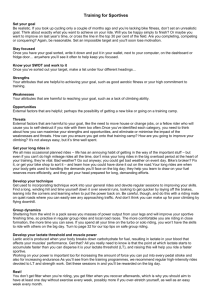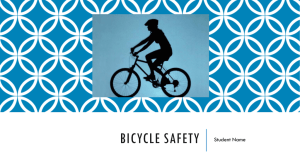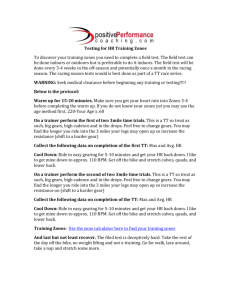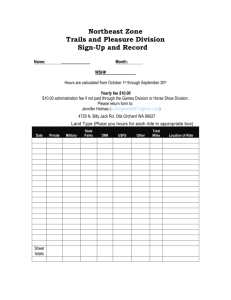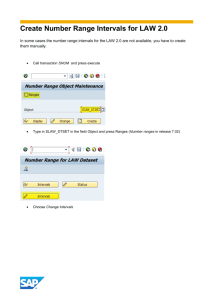Team_IMBA_Training_Plan-intro
advertisement
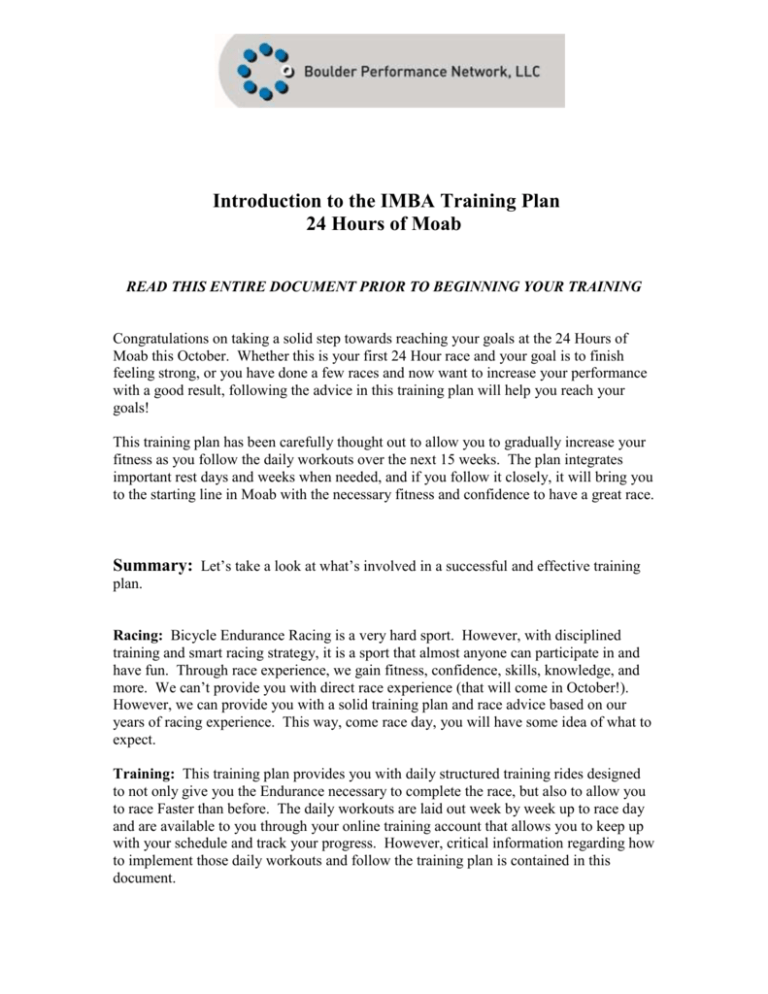
Introduction to the IMBA Training Plan 24 Hours of Moab READ THIS ENTIRE DOCUMENT PRIOR TO BEGINNING YOUR TRAINING Congratulations on taking a solid step towards reaching your goals at the 24 Hours of Moab this October. Whether this is your first 24 Hour race and your goal is to finish feeling strong, or you have done a few races and now want to increase your performance with a good result, following the advice in this training plan will help you reach your goals! This training plan has been carefully thought out to allow you to gradually increase your fitness as you follow the daily workouts over the next 15 weeks. The plan integrates important rest days and weeks when needed, and if you follow it closely, it will bring you to the starting line in Moab with the necessary fitness and confidence to have a great race. Summary: Let’s take a look at what’s involved in a successful and effective training plan. Racing: Bicycle Endurance Racing is a very hard sport. However, with disciplined training and smart racing strategy, it is a sport that almost anyone can participate in and have fun. Through race experience, we gain fitness, confidence, skills, knowledge, and more. We can’t provide you with direct race experience (that will come in October!). However, we can provide you with a solid training plan and race advice based on our years of racing experience. This way, come race day, you will have some idea of what to expect. Training: This training plan provides you with daily structured training rides designed to not only give you the Endurance necessary to complete the race, but also to allow you to race Faster than before. The daily workouts are laid out week by week up to race day and are available to you through your online training account that allows you to keep up with your schedule and track your progress. However, critical information regarding how to implement those daily workouts and follow the training plan is contained in this document. Rest and Recovery: You will also notice that your training volume (ride time) and intensity cycles up and down from one week to the next. The weeks with fewer hours are called REST weeks and are indicated in the plan as such. Also there are days indicated as DAY OFF during the week. Don’t ignore these; they are essential to making progress and gaining fitness. Remember: FITNESS = HARD TRAINING + REST Pace and Intensity: Smart pacing, through using both Heart Rate monitor and/or Perceived Exertion (PE), is critical to training and performance. Keep your pace under control (i.e. follow the workout as described) so that each workout does not lead to extreme fatigue and failure to do the next planned workout. There will be times when you are tired (especially after a long Endurance ride or after Lactate Threshold (LT) or VO2max intervals), but the stress due to your training effort, combined with the specified rest days, should allow for you to stay on the schedule. Try to get a sense for when you are going too hard (again using a HR monitor and/or PE). When you feel this back off a little before it causes problems. Athletes must set their ego aside and train at the appropriate pace. Easier said than done, but it is essential if you are going to get the maximum benefit from your training plan. Eat and drink during training: You will need to consume about 150 – 250 calories per hour & 15–32 oz of fluid per hour depending on your size, weather and pace. Practice eating and drinking while riding, so you know what you can handle without getting bloated. Everyone gets stomach problems, but that does not change the facts. We MUST eat and drink to finish the race and to perform well in training! Just practice in your training and find what works for you. It is possible to combine calorie intake with fluid intake by using sports drinks. However in really hot weather the sweetness of sugared sports drinks can be overpowering, so you might want to experiment with different concentrations. Practice being able to eat and drink without stopping. Using Camelbacks for hydration with a few side pockets that are easily accessible for storing food is a great idea. Food can be in the form of gels and solids. Just DON’T BONK on a training ride – nothing is worse for your fitness and it greatly slows down your recovery. Commonly Asked Questions: 1) What if for some reason I miss a day’s workout? Unless it is a “Red Dot” workout (see question below for explanation), don’t worry about the missed workout, just move on to the next day’s workout. If you do miss a day where the workout is marked with a “Red Dot”, then if you can, try to make up that workout on another day during the week as those workouts are a very important part of the training plan. 2) What do the red dots and “BT” mean (that show up in my training calendar) for certain workouts (usually 2 a week)? BT means “Breakthrough Workout”, which is a workout or two for that week which are crucial to the training plan and important to complete to allow for the training plan to work as it should and bring about optimal fitness and race preparation.. See question above in case you miss a day that is schedule with a BT workout. 3) Can I do any cross training such as running or gym strength workouts? Cycling is such a specific sport that it is important to do the majority of your workouts on your bike. However, some gym work concentrating on strengthening the core torso muscles, and working in upper body and some light leg strength training is fine to do once or twice a week. If you want to substitute a bike workout for cross-training such as running or swimming, substitute a shorter zone 2 ride (but you don’t have to swim or run for as long as the bike training ride was scheduled for – about half the scheduled time is sufficient. 4) Is it ok to do some workouts on my road bike, and if so, which rides should only be done on the mountain bike? Most of the rides on the plan can be done on either a road or mountain bike. LT and VO2 max intervals are best to do on a paved or dirt road climb since you can keep the effort level steady. The technical rides are meant specifically for the mountain bike. And it’s a good idea to do most of the longer zone 2 rides on your mountain bike to get used to the endurance pace and to feel comfortable riding your mountain bike for long periods of a time. Training Zones: The daily workouts in this training plan are all based around what we will refer to as “Training Zones”. Training Zones are established based on a field test (described below), and each Training Zone defines a certain intensity that you ride at, which corresponds to training the different energy systems your body relies on to ride a bike. If you have a Heart Monitor then we recommend setting up your Training Zones based on your HR. If you do not have access to a HR monitor, then you can still define your Training Zones based on what we refer to as Perceived Exertion (PE). Even if you do have a HR monitor, it is important to learn how your body feels in the different Training Zones and to refine your sensation of PE. Sometimes your HR can vary depending on temperature, altitude, hydration, and various other stressors, so even if you have a HR monitor, still pay attention to your PE along with your HR when training and racing. Testing to determine Training Zones: ***This should be done at the beginning of the plan before you do any of the LT or VO2max intervals. Have at least 2 easy days before your test. Testing on the first Tuesday or Saturday that you start the plan is best.*** To find your Lactate Threshold Heart Rate (LTHR), complete a 30-minute time trial as follows: Find a course which is relatively flat to climbing (try to avoid a course with long downhills). Warm-up as you would before a short race and then begin the time trial (test). Start your heart rate monitor immediately. This should be one with an average heart rate mode. The effort of this time trial should be race-like--give it all you have but slowly ease into it in the first few minutes, and finish strong. Ten minutes into the time trial (with 20 minutes to go) hit the 'lap' button on your heart rate monitor. At the end of the time trial hit the “lap” button on your watch again. What you want to have is your Average Heart Rate for the LAST 20 minutes of the time trial (so we aren’t worried about your average HR the first 10 minutes). This number (Avg HR for last 20 minutes of the test) is an approximation of your LTHR. The more times you complete this test and observe your heart rate relative to Perceived Exertion (PE) in workouts, the more refined your LTHR will become. You will use this LTHR number you just derived from the 30’ Time Trial test to compute your Heart Rate Training Zones. You will use these Training Zones to properly complete your training rides and be able to gauge your effort on the ride so that you are training at the specific intensity (or lack of intensity) that the day’s training ride calls for. To determine your HR zones, start with the LTHR number you determined from your test. Training Zone % of LTHR Perceived Exertion Active Recovery (Zone 1) < 81% 1 and 2 Endurance (Zone 2) 82 – 88% 3 and 4 Tempo (Zone 3) 89 – 93% 5 and 6 Lactate Threshold (Zone 4) 94 – 100% 7 and 8 VO2max (Zone 5) 101+% 9 and 10 ________________________________________________________________________ Example of how to compute HR zones – based on a tested LTHR of 172 Zone 1 Zone 2 Zone 3 Zone 4 Zone 5 <140 bpm (bpm = beats per minute) 141 – 153 bpm 154 – 160 bpm 161 – 171 bpm 172+ bpm After you determine your HR Training Zones, be sure to write them down and keep them in a place you can refer to them often when needed. Perceived Exertion (PE) Training Zones: PE is usually determined on a Scale of 1 to 10. With 1 being very, very easy, and 10 being so hard that you can only keep up that intensity for a few seconds at a time. When your breathing is a bit labored, and you can carry on a conversation but it is in halting words and breaths, you are probably at or very near to your LTHR. Usually this state would be given a PE rating of 7 or 8. So to determine your PE Training Zones, even if you don’t have a HR monitor, do the 30’ test described above and remember how it feels about 20’ into the test and rate that on a 1 to 10 scale. Concentrate on your breathing. When your breathing is very ragged and talking in multiple sentences is almost impossible, you are probably above your LTHR and riding in your VO2max zone. If your breathing is heavy, but you can keep it steady, and you can carry on a conversation but have to pause every now and then, then you are probably riding at your LTHR. You need to remember how these states feel as you will need to apply your PE sensations to the workouts in this Training Plan. Ride Descriptions Zone 1 - Easy Recovery Spin Just as it sounds, this is meant to be an easy day and can be done on either a road or mountain bike. Keep the cadence high and stay light on the pedals. The idea is just to spin the legs and aid in recovery from previous hard rides. Bike paths or gently rolling roads are the best places to do these rides. Avoid riding on singletrack or steep climbs on these days since it’s too hard to ride easy enough. Zone 2 – Longer Endurance Ride This is an endurance ride and is done at a pace you could sustain for many hours if you eat and drink enough while you’re riding. The effort level is moderate and conversation is possible. Try to avoid hard efforts on these rides but it’s ok to push a little harder on climbs and ease off on descents. For the solo and duo riders this is the pace you will be riding the most during the race so it is important to be comfortable and familiar with this effort level since that will help you not to start the race too hard. These rides can be done on either road or mountain bike but ideally most of the longer zone 2 weekend rides should be done on the mountain bike. Zone 3 - Tempo This is also called a tempo ride and is an effort level that is moderately hard, but conversation is still possible. These rides should start with 15-20 minutes of easy, zone 1 riding. Then increase the effort such that your HR gradually moves into zone 3 over several minutes. The amount of time spent in zone 3 can range from 30-90 minute blocks. Try to stay in the zone as much as possible during each block and avoid doing any harder efforts of more than 10-15 seconds. Finish the ride with at least 15 minutes of easy, zone 1 riding. Zone 4 - Lactate Threshold (LT) Intervals These are hard efforts in zone 4. During these efforts brief conversation is possible and breathing is heavy, but should still be controlled, not ragged. Start these rides with 15-20 minutes of easy, zone 1 riding. Then do one 5 minute “blowout” effort in zone 4, followed by 5 minutes of easy riding before starting the intervals. In the training schedule the number and length of intervals is given by a notation such as 4 x 10’ in zone 4, which means do 4 intervals in heart rate zone 4 of 10 minute duration each. The recovery time is also noted so that in between the intervals pedal easy or coast for the indicated time. It’s best to do these intervals on a climb where you can ride for at least 15 minutes without stopping. Be sure not to start the intervals too hard, which is very easy to do as it takes your legs a few minutes to start feeling the pain. So let your HR rise into zone 4 over several minutes and try to keep the effort level steady throughout. Finish the ride with at least 15 minutes of easy, zone 1 riding. LT intervals are emphasized in the training plans because they are the most efficient way of improving your ability to ride in zones 2-4, and that means racing faster. Zone 5 - VO2max Intervals These are very hard efforts in zone 5. During these efforts conversation is not possible and breathing will be very heavy. Start these rides with 15-20 minutes of easy, zone 1 riding. Then do 3 one minute “fast spin” intervals with one minute rest between them. These are meant to warm you up but not to be hard intervals. The effort level for these “fast spin” warm-up intervals should be roughly zone 4 and you should spin faster than 90 rpm. Follow these with 5 minutes of easy riding before starting the VO2 max intervals. The notation in the plan is similar to that for LT intervals, with 3 x 5’ referring to 3 intervals of 5 minutes duration each. As with the LT intervals, keep the effort level steady throughout the interval, and let your HR rise into zone 5 over the first minute or two of the interval. Finish the ride with at least 15 minutes of easy, zone 1 riding. Technical Rides The schedule includes one day a week for technical rides. These rides are meant for you to work on specific skills that will help on race day. For instance, ride a tricky section of singletrack several times, or do 8-10 “stomps”, which are full on efforts for 5-10 seconds to get over a steep section. The Moab course includes some sand so if possible practice riding in sand or loose dirt on some of these days. The effort level should mostly be easy on these rides except short periods when working on skills. Rest Days off in the plan are important, so be sure to take your rest as seriously as you do your longer or harder rides. Without enough rest and recovery your body can’t repair the damage caused by hard rides. Over time this will lead to fatigue and a lack of improved fitness. As you progress through the schedule pay attention to how you feel from week to week and if you are ever too tired to do a ride then skip it. It’s much better to do too little training than too much. Remember to train HARD and SMART!! Brad Seaman and Eric Ray are USA Cycling Certified Coaches with Boulder Performance Network LLC – www.boulderperformance.net Brad can be contacted at brads@boulderperformanc.net Eric can be contacted at eric@boulderperformance.net
